
If you only clean your rugs after a spill, think again. Rugs, like every part of the house, need to be cleaned frequently—and thoroughly. This is where your dirty shoes go. It’s what traps all of the dirt and dust from the floor. Rugs hover right by the ground, so they come in direct contact with every creepy crawler and every ounce of bacteria.
Now, imagine never cleaning that! You get the point—rugs need to be cleaned for a lot of reasons. Rug cleaning isn’t like dusting a dresser or wiping down the counter. In a way, it’s an art. Good news is it’s an art that you can master. There are several different methods to cleaning carpets and rugs, and when done incorrectly, a rug cleaning job could potentially destroy a rug.
So you’re faced with a few options:
1. Let it slip by the wayside. Who needs a clean rug? This leaves you with a dirty rug, excessive allergies, and eventually, bacteria growth.
2. I’ll clean it myself! Seems easy enough.
3. That sounds awful, so I’ll hire a professional.
For all-intensive purposes, let’s remove option #1. We’ll explain a little further why it’s actually not an option at all, but for now, let’s stick to options 2 and 3. If you’re ready to wash your hands of it and hire a professional, we’ll help you out with that. There are plenty of professional rug cleaning services that will be able to help you there.
The rest of you DIY-ers who are ready to jump in and start cleaning, let’s take it down a notch first. It’s easier said than done, and there are a lot of steps to cleaning a rug successfully, so we’re here to walk you through it. First, we’ll go through the basics —why you should clean a rug and what could happen if you have a not-so-great rug cleaning experience. Then we’ll show you how to avoid that mishap by having you follow along our step-by-step guide to cleaning your rug.
Sounds good? Let’s get started!
Why clean a rug?
First things first. Think about what comes into contact with a rug the most. Is it your hands? No. Your face? No. Your furniture? Maybe.
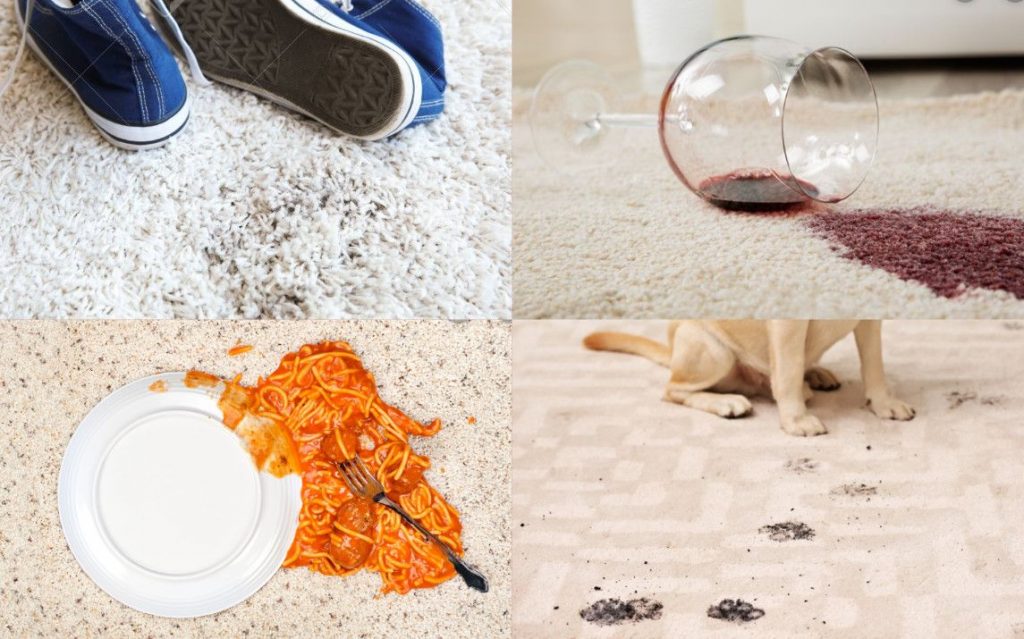
What really comes into contact with rugs more than anything else is feet—and therefore, whatever is on your feet. That means pet paws, human feet, socks, and shoes. None of those things are known for being sanitary.
Here’s the thing: You could have the cleanest feet in the world, and they still wouldn’t hold a candlestick to the level of clean you would need in order to skip a very much needed rug cleaning. Let’s face it —the bottoms of our feet, socks, and shoes are spent roaming this earth and everything it holds. Just to break it down, here are some staggering numbers to show you what’s really touching your rugs.
Feet:
The average foot contains over 250,000 sweat glands. Feet are associated with having an odor for a reason, and that’s because feet produce a lot of sweat! When you have that walking on a rug, the sweat, oils, and dirt all get trapped in the rug’s fibers.
Shoes:
A study done at the University of Arizona shows that when shoes are worn for more than a month, 93% of them will end up with fecal bacteria on the bottom of them. This fecal bacteria accounts for everything and anything you could imagine—from animal feces to splashes from public restroom toilets.
Paws:
Pets are cute and cuddly, but the bottoms of their paws are not. Because most animals don’t wear socks or shoes, their paws are exposed to all kinds of bacteria. Think about how much bacteria and fecal matter ends up on the bottom of your shoes, and envision that on the paws of your pups and kitties.
So you know how you and your pets are contributing to the dirt and bacteria, but there are other things lurking around in your rugs. Here are a few:
– Dust
– Dirt particles
– Hair
– Fur
– Bugs
– Food particles
– Oils
…and much, much more! All of these things together can pollute the air of your home and give you allergies.
How often should you clean your rugs?
Now that you know the importance of cleaning your rugs and you’re ready to jump in and try it out, it’s important to know how often you should do it. Cleaning a rug isn’t a one-and-done kind of deal. Like most household chores, it requires upkeep in order to make sure everything stays clean.
Good news is the upkeep isn’t needed frequently. Some people hear “rug cleaning” and think it’s a yearly, or even monthly, ordeal. That’s not the case at all. You really only need to do a deep clean once every 5 years (Carpet king Arash Yaraghi said it!). In addition to that, though, you do need to keep up with regular vacuuming sessions and spot treating as stains pop up every once in a while.
What could happen if a rug is cleaned incorrectly?
The short answer is: You could ruin your rug. Cleaning a rug incorrectly either 1) Causes a lot more work on you in order to dry it and properly clean it or 2) Completely ruins your rug.
As you know, rugs aren’t cheap. The average cost of an area rug is roughly $4.50 per square foot. That’s a lot of money that goes down the drain because of a faulty cleaning job.
Before your rug becomes a lost cause, learn the correct way to clean your rug all on your own. This way, you can avoid the costs of a professional rug cleaning service while also ensuring that your home is safe and clean including your rugs.
Before we get into matter…REMEMBER!
In order to keep your rugs clean, and therefore your home, it’s important to deep clean your rugs and carpets at least once every 5 years… and I would strictly recommend to hire a professional rug cleaner to do the deep cleaning for you. You simply won’t get the same results. Read our Ultimate Guide on How to Choose a Rug Cleaning Professional for more information.
Now, 5 years may seem a long time. Well, it is… if you don’t do a basic rug care once in awhile! And that’s what we are going to help you with here.
Manufacturer’s Instructions
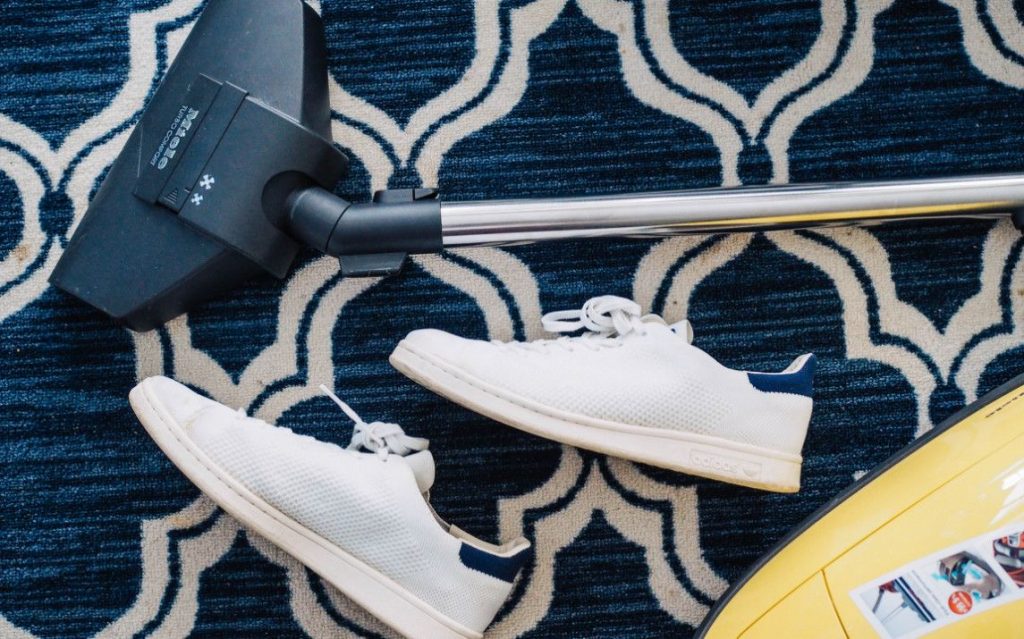
First things first…
In order to know how to properly clean a rug, it is important to know the material with which it has been made. The type of knot and the termination will also influence the way to proceed with rug cleaning, as well as the tools and cleaning products that we will use.
Before starting, we must always inform ourselves about the manufacturer’s instructions regarding dyes with which it has been made, to know if they are solid, or can be discolored (or look at the care tag that comes with the rug), in order to determine which sanitation treatment to apply. This way, and in addition to the general rug cleaning process we’ll guarantee the preservation of its color and texture.
The cleaning process also depends on the fibers with which they are manufactured. And that way after the General Steps to Rug Cleaning, we’ll walk you through the different types of rugs and their needs.
“If you want to extend the life of your rugs it is essential to vacuum regularly, and clean as soon as possible the liquid stains, not letting them dry.”
To maintain rug cleaning and extend its useful life, here are some useful tips:
– Determine what type of rug you’re cleaning.
– A good tip to avoid using harmful cleaning products on them, is to keep in store all care tags that come with any rug. This tags will be the best reference you have!
Tools & Products
Here are almost all of the tools you might need to clean your rugs at home (remember, not all of them can be used with every rug! Further on, you’ll see what works with each type of rug).
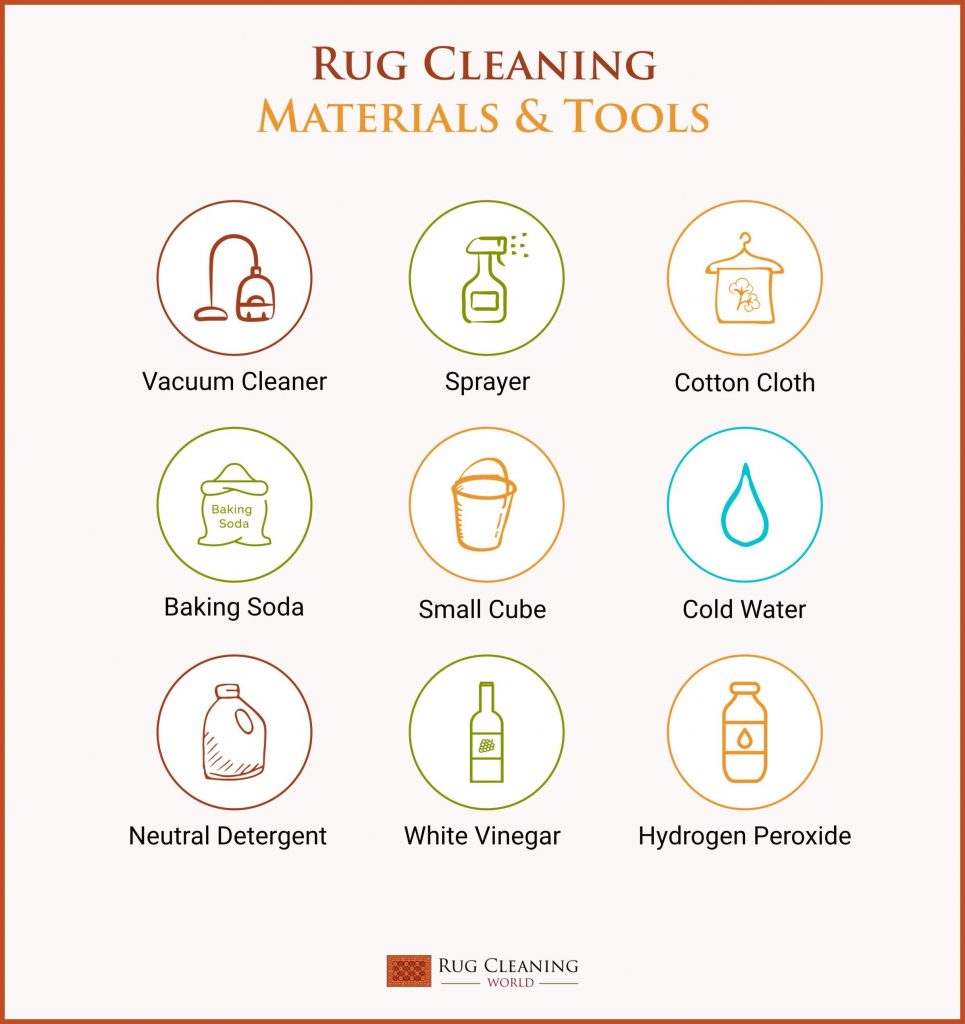
1. Vacuum cleaner (with brush). Check the best Vacuum Cleaners for 2022 here!
2. Cotton cloth or microfiber.
3. Sprayer
4. Small cube
5. Sodium bicarbonate
6. Neutral detergent
7. Hydrogen peroxide
8. White vinegar
9. Water (better cold!)
General Rug Cleaning Steps
Get your rug all cleaned up with these simple steps!
1. Shake it off
Step 1 may seem counterintuitive, but one of the best ways to get debris and loose particles out of your rug is by putting in a little physical labor. Take it outside or drape it over your balcony railing, and shake it until it feels like all of the loose, moveable dirt particles are out of it. You can also try using a broom—whatever you need to do to get the dirt out of it. This step makes it easier to vacuum and clean in the following steps.
PRO-TIP
THE FLIP & STEP TRICK
If you cant shake it off (for what ever reason) simple flip the rug upside down on a clean surface and step on it carefully, but constantly. Walk on it for a couple of minutes and the dust will fall. After a couple of minutes, clean the dust that has fallen from the rug. Repeat as many times as needed until no more dust comes out.
2. Take the odors away! (OPTIONAL)
Pleeeeaaase! Before doing this step, check the care tag of the rug. And only if it’s okay, take a can of sodium bicarbonate – if it is fresh better – and spread it all over the surface with a dry brush. This way, we’ll eliminate all the bad smells that have been adhering throughout the year. You can also substitute bicarbonate for common salt.
3. Vacuum
If you have done Step 2, wait until the carpet is completely dry.
Now that you’ve removed the big particles and shaken out the dirt as much as you can, you need a vacuum to get the fine particles hiding in the shag. If the carpet is short-haired, always aim in the opposite direction to the hair and if it is long, conversely.
(If you want to learn the best vacuuming tips and tricks, here I have an article prepared just for you!)
Depending on the type of rug, you’ll need to take the beater bar off or use a vacuum that doesn’t have a beater bar.
CAUTION!
The beater bar can damage the individual yarns of a rug because they’re so long and thick. The result of that is a less plush rug that ends up shedding and piling way more than you intended for it to.
Here’s the upshot: Vacuum well, but vacuum cautiously. Turn off the beater bar and keep it on a high setting for a few minutes. There’s no need to overdo it.
4. Give it a bath
Now that most of the particles are out of the rug, the next step is to get all of the oils and stains out of it, which calls for bath time. The type of bath you give depends on the type of rug you have. But, for almost all the following will do: use a well-drained mop, with a touch of neutral detergent or hydrogen peroxide – which is less harmful on the fibers – and let it dry. If you want to clean your rug even better, do it on both sides of the rug.
5. Top of the knotch! Leave it looking brand new!
Check that the weight of the furniture has not left any deformity on it. If the answer is yes, take an ice cube and put it on top of the “bun” until it melts completely. This way, the fibers of the fabric will return to their original position. (Seriously, best tip ever!)
Cleaning tips for each type of rug
On this section of the guide, you’ll find useful information about what type of products to use in every kind of rug. Find your type of rug and and then you’ll be ready to start cleaning! (If you’re not clear about what type of rug is yours, here you have a guide with all the different types of rugs and their characteristics.)
But first of all, I want to insist on the need to vacuum well both sides of the piece, to remove all kinds of dust particles, sand, etc., because if you don’t, you’ll end up producing mud while applying liquid products when cleaning carpets, leaving the rug completely soaked and maybe irrecoverable.
It’s also very important to carry out a test, in a small area that is not very visible, with the product that we are going to use. Test the resistance of the colors in a little visible corner, and apply the products gently and in small quantities, before applying it to the whole rug.
First, we need to differentiate between two types of rugs: Natural Rugs and Synthetic Rugs.
Natural Rugs
When cleaning Natural Rugs its when we have to be more careful. And the safest way to clean them is using dry cleaning products. Here you’ll see the 3 most common natural rugs and their tips to keep them clean.
Wool rugs:
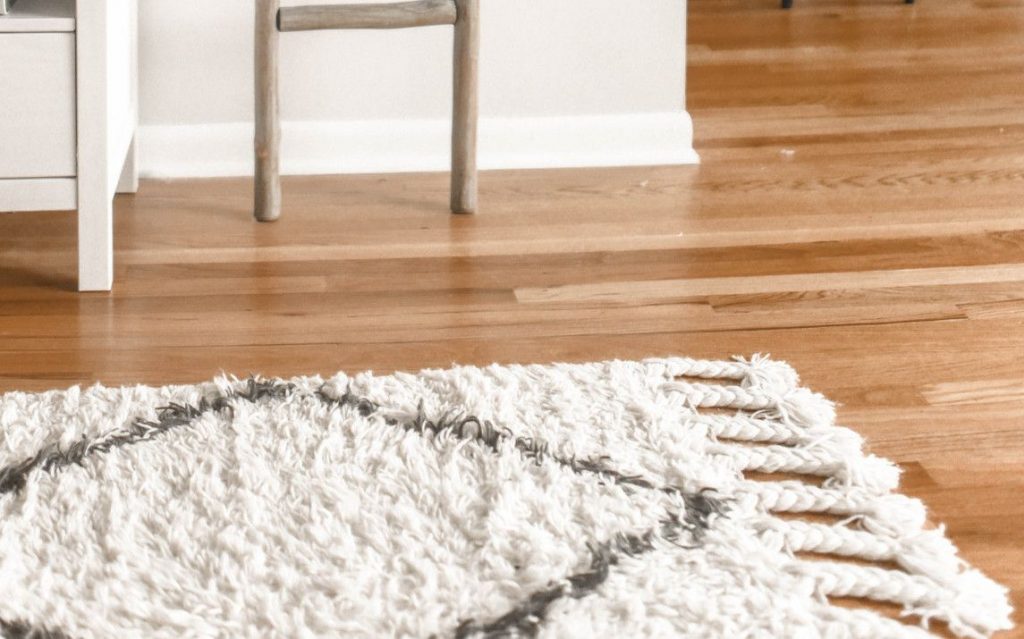
– Do NOT wash in a washing machine.
– Use a natural bristle brush and brush thoroughly. If your carpet’s hair is short, this action does not have much mystery or complication. However, if the hair is long you must be careful because it can be tangled and you can break it. In the end, it doesn’t take as much time as it seems and the carpet looks like new.
– If you want it to be perfect, you can use an adhesive roller to remove fluff, such as those used in clothing.
– We do NOT recommend using a steam cleaner at first, as hot water can shrink wool and spoil the rug. However, steam cleaners have different programs and if you follow the manufacturer’s instructions and choose the specific method for wool rugs, the results are amazing.
– Natural products you CAN use: sodium bicarbonate to neutralize bad odors and remove stains if you mix it up with water, white vinegar and neutral detergent.
– ALWAYS use cold water!
– Do NOT use bleach or ammonia, if you have a coloured rug.
Vegetal Fiber Rug:
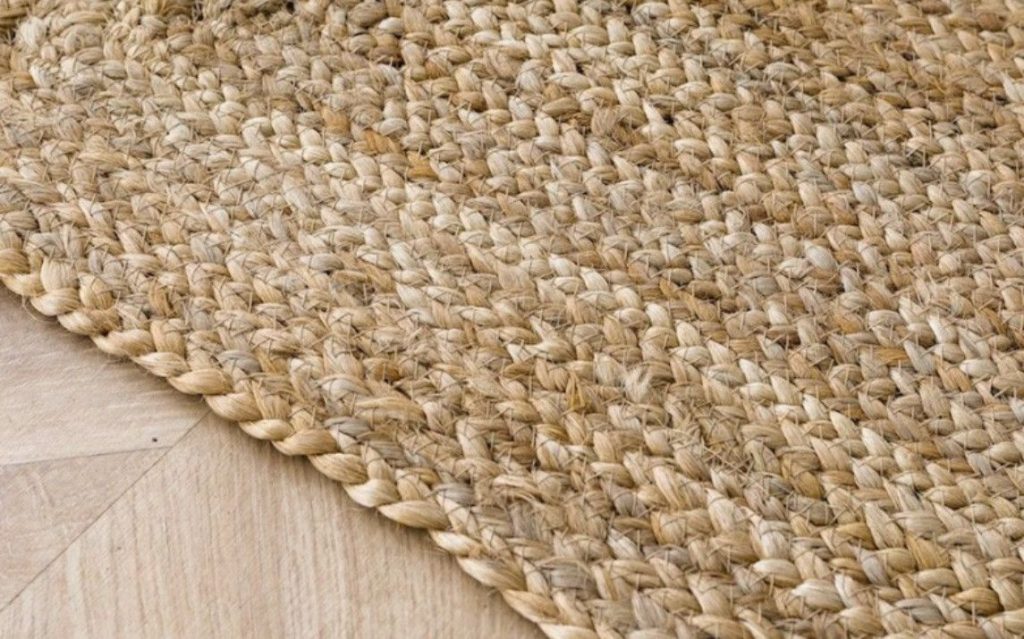
– It is always better to dry clean.
– NEVER use a Steam Cleaner!
– Spray sodium bicarbonate on the carpet before vacuuming to remove odors.
– Cut the loose strands to prevent them from untangling even further.
– To remove a stain use a well-drained cloth, previously soaked with water and neutral soap/detergent. Always wipe the cloth from the outside of the stain inwards.
– Dry any liquid stain with a dry paper towel or a clean cloth immediately.
Leather rug:
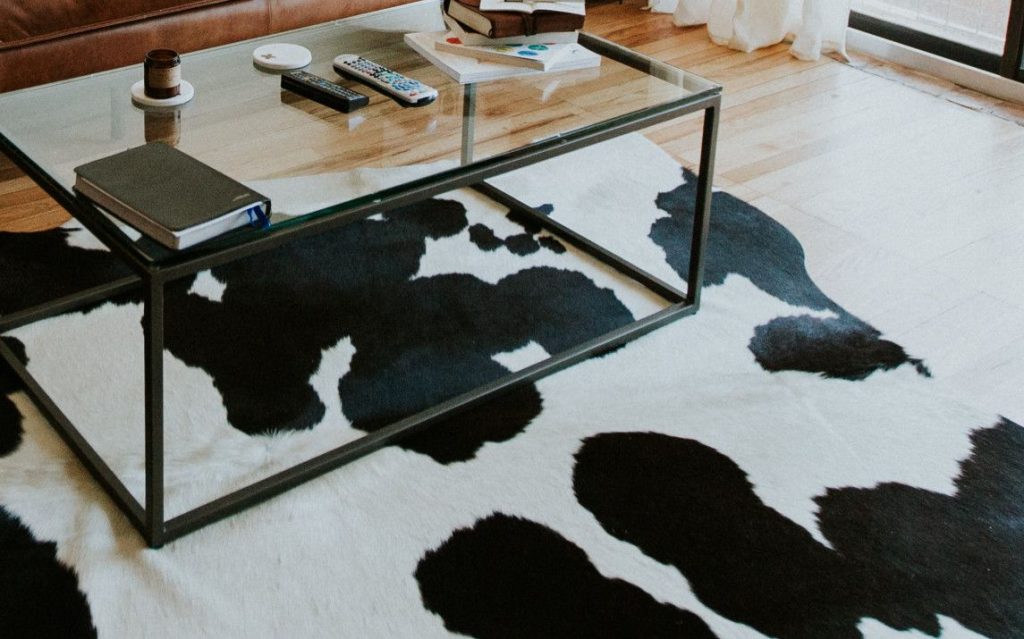
– It is always better to dry clean.
– You can use any type of accessory for the vacuum cleaner, as long as the brushes do not rotate to avoid damaging the skin. Vacuum in the direction of the hair. If it is a rug with long animal hair, it is better to avoid using brushes.
Synthetic Rugs (Acrylic and Polypropylene)

Now, changing to Synthetic Rugs we find 2 types: Acrylic Rugs and Polypropylene Rugs. But the great thing about all of them is how easy they are to clean and maintain. They’re less delicate and therefore, we can use a great variety of products in order to get that smell or stain away! Here are some tips for all of them:
– Most synthetic Rugs are machine washable. Check the rugs care intructions if you’re unsure. If so, through it into the washing machine (using laundry detergent and a stain remover if you want to). A pro-tip would be to add a cup of vinegar to the rinse cycle or the fabric softener dispenser. This will eliminate all odors, as vinegar is a natural deodorizer. To dry it place it in the dryer if the care instructions say its okay. I not, hang it somewhere and leave it to air-dry.
– You can handswash it using a mild laundry detergent and white vinegar
– Rugs with rubber in the back can only be handwashed and never put them in the dryer. They can catch fire!
– If you want to decrease the amount of time you need to clean your rug, use a steam cleaner instead. It uses fewer moisture. Check the best steam cleaners of 2022!
Best way to use Natural Cleaning Products
To wrap up, here are some natural cleaning products that you can use to clean your rug:
– Salt: it’s perfect for disinfecting and cleaning rugs. To remove stains, all you have to do is throw a layer of salt on top, roll the rug and leave it for a few hours. Then, the only thing left to do is vacuum!
– Hydrogen peroxide: works great with liquid stains. Apply a little on the stain you want to remove and leave it alone, so it can do its magic! Then dry the rug wiht a dry paper towel or clean cloth.
– Sodium bicarbonate: valid for all types of rugs, helps eliminate odors and stains
– Amonia: useful to remove stains but try it before in a small area of the rug, because it isn’t a good solution for all rugs. The best way to apply it is to mix it up with hot water and apply it with a vaporizer.
– White vinegar: it usually works well with all kind of rugs. Don’t worry for the smell; once it dries, the scent goes away. Useful to remove almost all kinds of stains: fruit, tea, milk, chocolate, wine, blood, etc.
– Cornstarch: ideal for oil stains. You just have to sprinkle some of it on the rug stain and let the product stand for 30 minutes before vacuuming. Finally, review the entire intervened area with a dry brush.
– Alcohol: removes traces of sugar and glue but is advisable to try it on a small area of the rug first.
Conclusion
And that would be it!
You’re now ready to be the best home rug cleaner ever!
Cleaning your rugs may not be the most fun chore in the world, but it’s certainly necessary. This comprehensive guide should give you a good idea of what to do with your rugs so that it’s not as much of a chore.
Good luck and happy rug cleaning!
